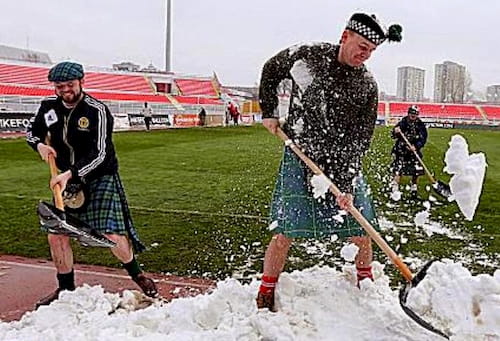Cycling in the winter can be quite comfortable. It is said: “there is no bad weather, only bad clothing”. How to dress for winter cycling? What are the challenges of riding in the coldest part of the year? All this will be explained in this post. Separate posts explain bicycle snow riding technique and bicycle winter tyres.
Table Of Contents (T.O.C.):
- Aren’t you cold?
- Uncomfortable riding conditions
- Rain clothing
- Clothing for freezing temperatures and snow
4.1. Head
4.2. Torso
4.3. Hands
4.4. Feet - Sweating
- Video demo of winter cycling clothes
1. Aren’t you cold?
This is the most common question winter cyclists are asked, wherever they go. What many people don’t know is that pedalling generates a lot of extra body heat – like a heater installed beneath one’s jacket. 🙂 The only problem with winter cycling is the wind. If body is protected from the wind, sometimes (at temperatures around freezing) less clothes are needed than for walking, or just standing outside, waiting on a bus etc.
2. Uncomfortable riding conditions
When it’s extremely hot outside, riding bicycle can be uncomfortable. Also, when it is cold and raining at the same time, riding is also uncomfortable. In all other conditions, with proper clothing, riding is comfortable, enjoyable and FUN. 🙂
Riding in extreme heat requires drinking lots of water and keeping body protected from direct sunlight – head especially. This will require a separate post, winter cycling will be explained here – rain, low temperatures, snow.
3. Rain clothing
Summer downpour isn’t critical. One easily gets wet, but also easily dries. Not much can save one from getting wet in a heavy downpour. Cold autumn and winter rains are what makes problems.
Good solution for shorter rides without much wind can be poncho rain capes.

Downside to such ponchos are that in strong wind they can pose a problem, and that for longer rides, since they don’t breathe, rider will sweat a lot – getting wet from sweat, if not from rain. For rides up to 5 kilometres, with fenders and good shoes, this can be a good solution – if there’s no strong wind.
Alternative to this are fast drying clothes, with a change of clothes. Since body creates a lot of heat, for rides longer than 5 km it is enough to wear a wind/rain proof jacket, or just a vest – even jacket can often be too hot. Underneath the jacket, wear a layer of modern synthetic quickly drying clothes with a change of clothes when reaching destination.
There are a lot of combinations in between, depending on the amount of rain, distance travelled and rider’s sensitivity.


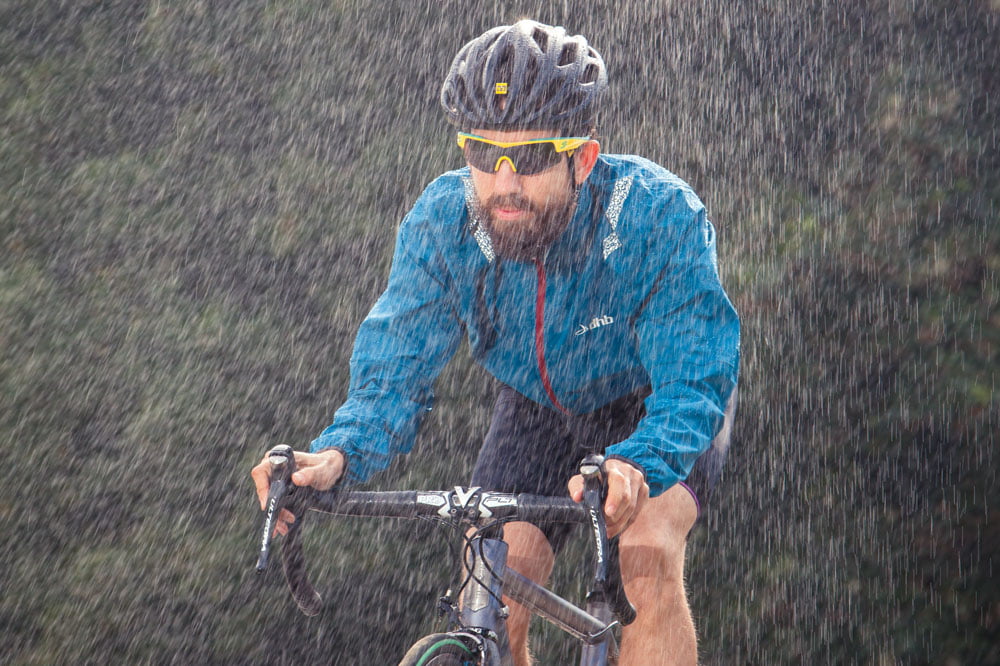

For most rain rides the hardest part is getting out in the rain in the first place – afterwards it’s easy. With experience, one will find the clothing and style that suit them best.
Golden rules of rain cycling:
- fenders (mudguards) for the bicycle
- good jacket (or rain poncho)
- good shoes
- avoiding puddles, since they might be hiding a hole in the pavement
4. Clothing for freezing temperatures and snow
How to dress for winter cycling? Can you believe that cycling in freezing temperatures can be comfortable and enjoyable? It can and it is. 🙂
It was already mentioned that body produces a lot of heat during pedalling. This can not be underestimated nor stressed enough. That is why it is most important to protect the body from the wind, while heat insulating layers needn’t be too thick.
Critical parts are head, torso, feet and hands. Clothing layers from head to toe will be explained.
4.1. Head
Head band that covers forehead and ears. If it gets too cold, a cap can be added, alone or as an addition – over a head band.

Cycling glasses for the eyes, or, when it gets freezing cold, ski goggles are a better choice – it gets very comfortable and warm, without getting too hot.

The picture confirms: as long as head, torso, hands and feet are insulated, there’s no cold on the bicycle! 🙂
Scarf or a balaclava over neck and face. Some balaclavas are made with openings for mouth and nose so they can protect the face from strong freezing wind.
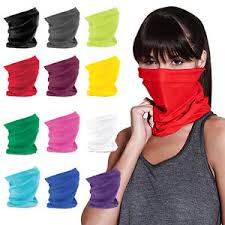
There are various models, with or without mouth and nose openings
4.2. Torso
Vest is in the first place. If there’s no chilling wind on one’s chest, the feeling of warmth is much stronger. Often, especially for longer rides, it is enough to put a vest over a sweatshirt, gets too hot for a jacket!

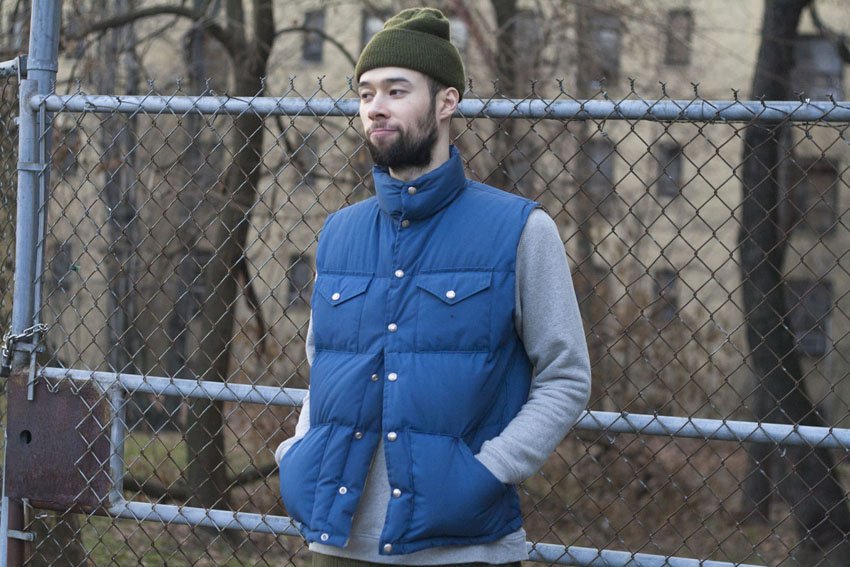
Next level is a wind proof jacket – with long sleeves, but not much insulation. Only for deep sub zero is a thick winter jacket required. Pedalling keeps you warm. You won’t be cold like people standing and waiting on a bus station. 🙂

The man standing is freezing in big jacket, while pedalling keeps the cyclist warm.
Crucial parts are covered: head, torso, hands and feet.
4.3. Hands
Gloves, what else? Thin, then thick, then thick with thin ones beneath. 🙂 There are also special mittens mounted on handlebars, for really low temperature riding. For most winters, regular skiing gloves are good enough.
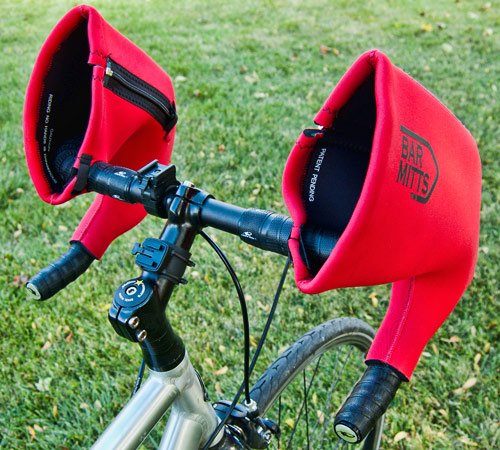
4.4. Feet
Good winter boots or shoes. With wool socks if a ride is longer.
Additional layers are added according to ones preference and needs. Body adapts to conditions, so if cycling is regular, one feels less cold as the days of winter cycling go by.



5. Sweating
Finally, a few words about sweating. In freezing weather, sweaty clothes quickly turn to icy clothes. Unless one has a chance to change into dry clothes upon reaching their destination, it is important to prevent sweating. Dressing in layers and removing them as one gets warmed up is a good idea. Also, for rides over 20 minutes, it is good to start a bit “under-dressed” – so that one feels slightly cold when starting. Provided there are good wind stopping layers, heat will quickly build up. My rule of thumb for longer winter rides is: if I’m comfortable as I step outside, I’m dressed too warmly and will “boil” rather quickly.
Backpack with place to store extra layers of clothes and put them back on when needed is very handy for winter cycling. Preferably placed on a rear rack of the bicycle. 🙂
Additional posts on this topic are bicycle snow riding technique and bicycle winter tyres.

